Planeswalker's Guide to Khans of Tarkir, Part 2
This is the second of two Planeswalker's Guides, which together are split into seven sections. Part 1 contains the introduction, Abzan, Jeskai, and Sultai. Part 2 concludes with Mardu, the Temur, and Tarkir's Planeswalker visitors.
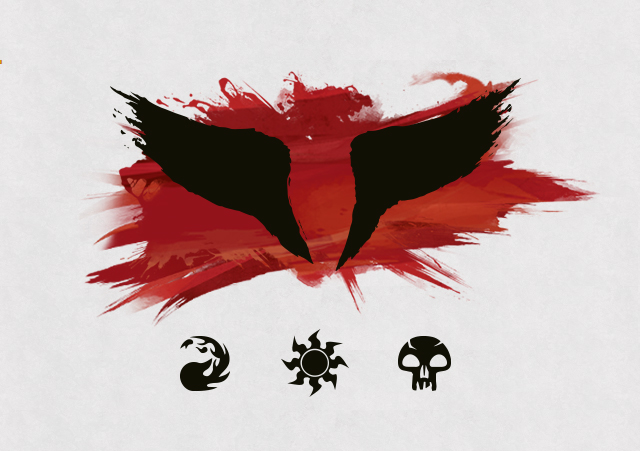
The Mardu Horde
Clan Overview
Speed, brutality, and honor. The Mardu emulate the speed of the dragon, and the wing is their symbol. The Mardu are a feared warrior culture. Ruled by a code of honor, they are constantly at war, conquering lands with fierce battlefield tactics, matchless archery, and brutal war magic. They are symbolized by the wing of the dragon, representing their swiftness on the attack, and they mobilize in great, thundering waves of human, orc, ogre, and goblin warriors. Their success in conquering territories may be unmatched, but they live for the hot moment of battle, not for the slow years of ruling the lands they overtake.
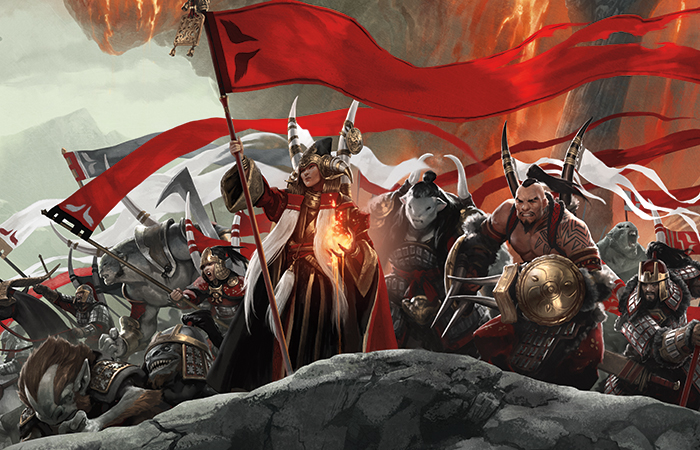
Art by Jason Chan
Clan Values
Edicts of Ilagra. Although not every member of Mardu society rides to war, every Mardu abides by a warrior's code called the Edicts of Ilagra, named after the first khan of the clan. The Edicts, inscribed on a collection of dragon-hide scrolls, govern the rules of honor and combat for Mardu warriors.
- To conquer is to eat. At the heart of the Mardu philosophy is the idea that a warrior earns by taking. They view the world through the lens of scarcity. There are more mouths than there are days of grain, so the one who fights best gets to eat.
- To rule is to bleed. On the other hand, the Mardu rarely rely on committing resources to a particular place. They spend little energy creating permanent infrastructure or integrating conquered peoples into their culture. It's common for Mardu armies to blaze across a territory, take a week's worth of grain, then move on without establishing any sort of settlement.
- Victory or death. When the Mardu go on the attack, they go full tilt. The archetypal image of a Mardu warrior is her riding into battle, leaning forward, standing up in the stirrups, sword out or bow at the ready—demonstrating great agility and riding mastery, but also demonstrating a willingness to sacrifice everything to hit hard and destroy the enemy. The Mardu leave nothing in reserve, preferring to die rather than fail.
War names. After coming of age, each Mardu clan member is eligible to prove him- or herself in an act of brutal honor. This usually involves the killing of an enemy in battle. The clan member then earns a war name, a new surname that usually takes the form of a compound word (e.g. Qorin Skullcracker, Jaidar Sharptusk). A Mardu who has not yet earned a war name is a "soft heel," while one who has is worthy of the term "warrior."
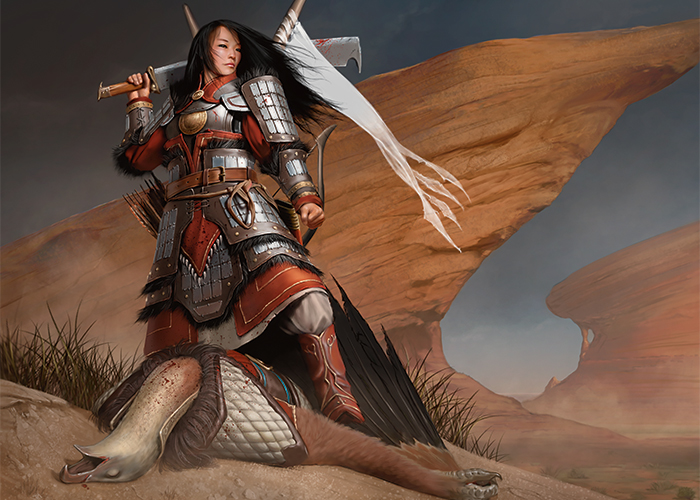
Art by David Gaillet
The privilege of the khan. Within the Mardu Horde, the khan is an absolute, despotic tyrant—but one who commands legitimate respect. Every khan who has taken command of the Horde has been a powerful and fearless warrior. Many Mardu khans have worn a bone trophy of the previous khan somewhere on their person, whether they lifted it from their fallen predecessor on the battlefield or took it personally in a duel to the death. Most Mardu warriors are fanatical in following their khan, toward whom they feel an almost religious awe.
Attitude toward dragons. The Mardu were among the most efficient hunters and slayers of dragons. They adopted concealment magic early on, disguising their warriors' strengths and setting up efficient, speedy ambushes. Today, they treat the memory of dragons with scoffing disdain, taking the extinction of the dragons as evidence of their own merit. This attitude never sat well with Sarkhan Vol, who grew up as a talented Mardu warrior before he discovered his talent for draconic magic, clashed with his own clan, and left the plane.
The push of the wind. The steppes and plateaus of Tarkir are swept by cheek-prickling, knuckle-chapping wind. The Mardu are fond of spiking banners in newly conquered lands, even if it's only a day before their enemy catches up to them. The wind turns the banners into the shape of a dragon's wing, and many Mardu believe that the wind is the world's way of pushing them on to conquer another day.
Clan Structure
The Mardu are a seminomadic culture with a large proportion of full-time warriors. Mardu armies wage war constantly, raiding and plundering enemy territories to sustain their culture.
The warriors. The Mardu cannot sustain themselves without war. They have little homeland infrastructure or agriculture to provide food or shelter and are constantly in danger of being unable to survive through the year. And while their warcraft is fearsome, they do little to occupy or hold claim over the lands they conquer. For the Mardu, war is not just a way of life—it is the way of life.
The labor class. The Mardu do have agricultural workers, especially shepherds for herd animals and wranglers of war-beasts, and many Mardu craftspeople create fine weapons and armor. But these are not enough to sustain food for the ravenous Mardu armies, and their work must always be supplemented by war plunder. However, the labor classes enjoy a measure of social freedom. As Mardu warriors are almost always involved in skirmishes on multiple fronts, the labor class is generally left on its own, and tends to have more representation in domestic matters than the lower classes of other clans.
Clan Magic
Dakla, the Way of the Bow. The Mardu have elevated archery into an art form, combining it with shamanic magic into a discipline called dakla. They use ritually blessed bows and specially enchanted arrows as foci for impressive magical effects. The Mardu don't have "archmages," per se. Instead, champion archers weave powerful spell magic into their art. Volleys of whistling arrows raining out of the sky are often the first sign of a Mardu attack, and many battlefield generals have met their demise by being targeted by Mardu heart-piercers.
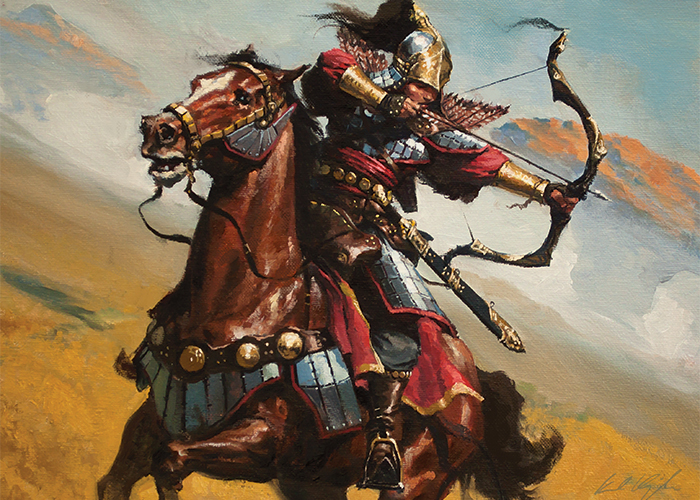
Art by Karl Kopinski
Concealment magic used in battle. For generations, the Mardu have used concealment magic, an evolved form of draconic magic from ancient times. The Mardu use concealment as a support magic for battle, primarily to disguise the strength of their warriors. Concealment can be used to create ambushes and to set up flanking maneuvers on unsuspecting enemies. On the other hand, Mardu archers often target concealed foes first to prevent being overwhelmed by similar tactics.
Mardu war shrieks. The battle cry of a Mardu warrior is itself a kind of magic. Mardu warriors and shamans can use war shrieks to strike fear in their foes, enhance their strength and skill, or even lash out with shock waves of sonic power. Mardu chiefs trace this tradition back to the breath of the dragon itself.
Conjuring the wind. The steppes and plateaus the Mardu call home are constantly raked by winds. Mardu shamans use great winglike motions to control and manipulate the wind, using it as a weapon against their enemies or guiding archers' missiles more effectively.
Clan Roles
Archers. Many Mardu warriors are expert archers, and some carve bows out of the dragon bones that litter Tarkir's landscape. Practitioners of dakla, the way of the bow, weave magic into their archery. Bowriders train in mounted archery, and can ride at breakneck speed while still skewering an enemy from across the battle. Heart-piercers specialize in long-distance assassinations, using magic to enhance the range and accuracy of their missiles. Gutstretchers use enormous heavy bows that can devastate even giant-sized opponents; gutstretchers are often orcs or ogres.
Shamans. The Mardu have a contingent of shamans, but their magic is more about action than about wisdom and rituals. Mardu shamans are tested on the field of battle. Chasm shamans move the very earth to create rifts to trap, slow, or isolate enemies. Ragesingers influence a warrior's fighting, often by using ferocity-enhancing spells on the warrior's mount creature. Woe reapers channel the pain of their enemies' death-cries to power their magic.
Riders. The tradition of mounted warriors is an art form among the Mardu. Valley dashers are swift riders meant to ride down and crush the enemy before they can react. Saddlebrutes are huge orcs or ogres who ride massive megafauna beasts. Solos are champion riders or mounted assassins who ride alone, employing stealth and magic to hunt down and eliminate the clan's enemies.
Leaders. Hordechiefs are battlefield generals, second only to the khan of the clan. Wranglers train and manage horses, giant falcons, and even ogres and giants. Feudmasters are mages and tacticians, often employed to keep track of territories, army deployments, and the names of all enemies who have slighted the Mardu and deserve to be raided next.
Important Clan Figures
Zurgo Helmsmasher. At the cliffs where an ancient lightning dragon died lies the Mardu stronghold Wingthrone, the heart of the clan's war effort. Zurgo Helmsmasher, a huge orc and the current Mardu khan, rules from atop a throne made from the dragon's skull. He commands the movement of Mardu raiding parties, relying on scouts and seers to deploy his troops, and striking where his clan's speed can exploit gaps in others' preparations.

Art by Aleksi Briclot
Zurgo was present at the battle where Sarkhan Vol's Planeswalker spark ignited. Many of their own Mardu clan were killed when Sarkhan unleashed a torrent of dragonfire across the battlefield. Zurgo survived, but by the time he reached Sarkhan's location, Sarkhan had already disappeared. In the aftermath, Zurgo claimed victory and became a hero, quickly rising to leadership over the clan.
"Those who ride will conquer, while those who stop to meditate will die. Fast horses and good bows make better war gear than all the monasteries and siege machines in the world."
—Zurgo Helmsmasher
Yasimin Ankleshank. Yasimin, often just called by her war name Ankleshank, is a female goblin warrior who's famed for her rash battle expertise. She's reckless and fearless, often rushing into battle without support from the rest of her horde. She famously never holds onto one weapon for very long, preferring to switch to the weapon her most recently slain enemy wielded.
Important Clan Locations
Wingthrone, the Mardu fortress. Where a great dragon died, smashed against a cliffside, the Mardu built the heart of their war effort. The Mardu khan sits atop the dragon's bony muzzle, literally a throne made from a dragon's skull, demonstrating their domination of the greatest predators Tarkir ever knew. It is a center for raiding news: scouts and seers come to Wingthrone to bring reports of clan movements, poorly defended weak points, and supply chains.
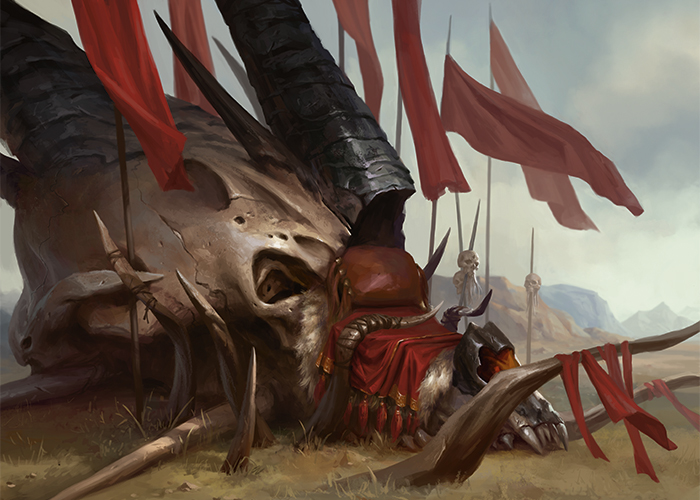
Art by Daarken
Other than Wingthrone, the Mardu rarely hold any given stretch of territory for long. The Mardu commonly range across wind-raked plateaus, grassy steppes, swampy scrublands, rocky valleys, and hoof-trampled trails over the rolling plains. Still, there are regions that are frequently part of the Mardu domain, or locations that hold special significance for the clan.
Goldengrave. Not far from the stronghold of Wingthrone lies Goldengrave, a grassy expanse where many Mardu battles have been fought. Chasm shamans tear apart the land to drop invaders into chasms, or to bury those battlefield dead that have been stripped of their supplies.
The Scour. A deep chasm passes through the Qal Sisma mountains in Temur territory, and that chasm continues like a scar into Mardu lands. The Scour is eroded by constant winds spiked with a fine black grit. The sere winds alone can skeletonize a corpse in a day.
Screamreach. A system of chilly bogs connect the lowlands near Wingthrone to the rolling meadows opposite Sandsteppe Gate. Orcs and swamp ogres dwell here in Screamreach. The fen takes its name from the yelps of pain of the denizens' victims, but also from the screeching ravens that dwell in the hollow trees.
Clan Creatures
Goblins. Mardu goblins are dangerous, tenacious fighters. They don't often ride mounts themselves, but they are able to cling to the backs of other mounted warriors, hopping from one rider to another. Goblins live among the humans and orcs of the clan, but are generally ignored, like dogs at a feast. Other than Ankleshank, few goblins have attained a warname in the Mardu's history.

Art by Zolton Boros
Ogres. The massive ogres are stronger than orcs, but of feral-level intelligence. They are uncontrollably violent and are kept chained until they're sent at the enemy to stir up chaos and cause destruction. The Horde often makes camp near huge boulders so they can chain down their ogres.
War horses. The Mardu breed lean, strong, and famously fast war horses. Riders train with their mounts from childhood. Many Mardu warriors are more sure-footed in the saddle than on their own two feet, and their sturdy stirrups allow them to stand (or squat, or ride up on their knees) while riding at high speed. That, combined with the horses' keen balance and smooth gait, allows Mardu riders to absorb the shocks of riding and gives them freedom of movement for their mounted archery.
Falcons. The Mardu train falcons as hunters—and as mounts. Enormous rocs perch directly on specially built extensions of Mardu saddles. Some Mardu warriors decorate their rocs' wings with banners that resemble dragons' wings, giving the birds a fearsome four-winged appearance.
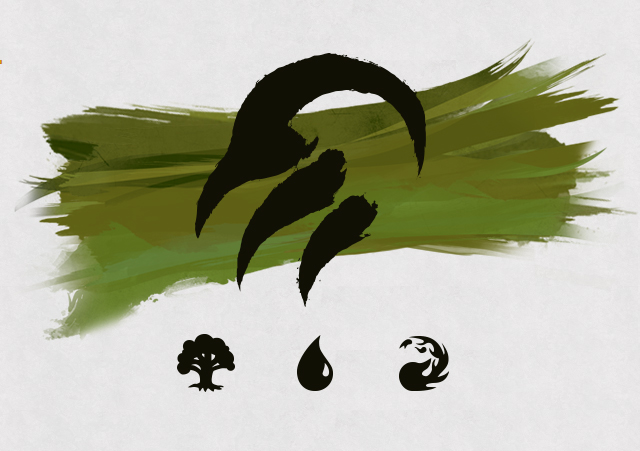
The Temur Frontier
Clan Overview
The Temur emulate the savagery of the dragon and revere strength and self-sufficiency, adopting the claw of the dragon as their clan symbol. Their khan carries the honorific "Dragonclaw." They have proved their toughness by carving out clan holdings in the inhospitable territory of the Qal Sisma mountains.

Art by Jaime Jones
A nomadic people, the Temur spend much of the year following prey beasts and raiding other clans, particularly the Mardu. They harbor little desire for expansion or conquest, but they fiercely defend their community against intrusion, both physical and cultural.
"They are closest in spirit to the dragon, and in some ways they still live within the Time of Dragons. Their shamans can see what should be. Through their whispers I might find the way to heal this damaged world."
—Sarkhan Vol
Clan Values
The past is with us. Shamans speak of "frozen memories," but every Temur lives simultaneously in the days of the ancestors and in the present. Clan roles are eternal, with each new generation assuming the ongoing mantle of a role: hunter, leader, whisperer, nurturer, slayer, and so on. Clan legends speak of these roles rather than named heroes.
Sleeping ancestors. Life is tough in the mountains. People die often. Burial is difficult in the rocky and often frozen lands of the mountains, especially in winter, and fuel for fire is scant, so the Temur have developed a practical solution. When someone dies, the corpse is washed (or at least rubbed down with snow), then wrapped in a ceremonial cloth. The other family members carry the deceased to a special site consecrated to the ancestors, a crevasse in the great glacier where the frozen dragons sleep. Amid prayers and offerings of aromatic smoke, the corpse is lowered into the chasm to sleep with the ancestors in the eternal ice.
The Endless Silence. Very rarely, a Temur might commit an offense that is unforgivable, such as cowardice in battle leading to the death of clan members, or acts of betrayal. Guilt is judged by the Dragonclaw, with the advice of the One Who Whispers Twice. The punishment for such heinous crimes is not just death, but utter removal from the clan's memory. The offender is drowned in a rushing mountain stream, and the corpse is swept away by the rapids to be devoured by wild beasts. That voice will never join those of the sleeping ancestors.
Whispering. Temur magic is highly shamanistic, with a strong elemental flavor. Shamans call their magic "whispering" and speak of the frozen memories and even the frozen spirits of the ancestors. Many Temur have an elemental affinity that allows them to shape stone and ice to varying degrees. Those with the strongest talent construct fortified cave shelters and can manipulate the terrain in battle to hinder the enemy and strengthen their own position.
Concealment magic among the Temur uses this belief in the frozen past. Shamans whisper to the cold air and the ice. Glaciers, especially those containing the remains of dragons, are considered the most sacred sites. A shaman performs a ritual, "the thaw," in which the shaman strips off his or her heavy clothing (other than the ceremonial headgear) and meditates on the ancestors. As the shaman slips deeper into trance, the shaman's body begins to glow and throw off heat. The skin is flushed, and the air nearby shimmers. The shaman begins to sink into the ice until he or she becomes encapsulated within a bubble of air; the melted ice re-freezes above, and the shaman's headgear rests on top like a turtle shell.
After a period of communing with the frozen memories, the shaman breaks open the icy capsule. Two beings emerge: the newly awakened shaman, and a barely visible double, seemingly made of clear ice, which encases him or her like a skin. The ice twin separates and stands guard, awaiting orders, as the shaman, now shivering and nearly dead from hypothermia, quickly dons the cast-off clothing. Although it physically resembles the shaman, the ice twin carries within it the awakened memories of a Temur ancestor. When in battle, it can suddenly shatter to release the warrior spirit within. Once the fight is over, the awakened spirit dissipates to return to sleep in the frozen mountain.
The Wide Whisper. The clan's chief shaman is able to enter a trance communion with all of the other shamans, regardless of distance. Through this, the chief shaman exchanges information and, when a mighty summoning is needed, can lead a "wide whisper" that involves the whole group. Such powerful rituals can awaken a very ancient ancestor or raise up a mighty elemental spirit.
Awakening the bear. Certain Temur warriors can enter a battle fury called "awakening the bear." It is thought they learned this from the ainok who share their territory. Their companions stay far from the "awakened bears," since while in this state, they cannot distinguish friend from foe.
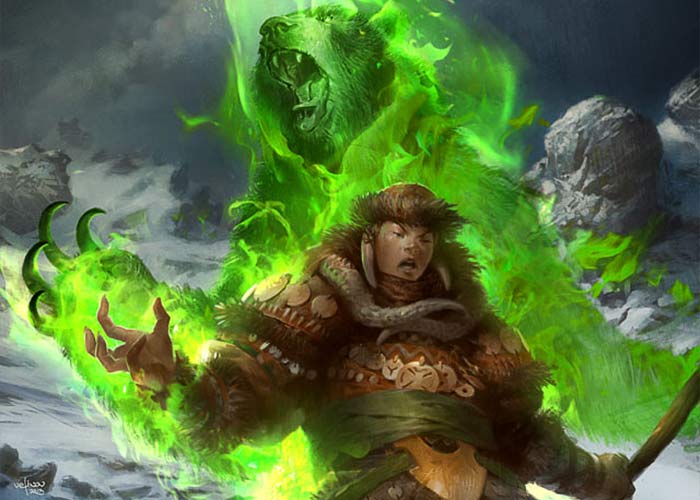
Art by Svetlin Velinov
Test of Claws. The Temur have retained their traditional wrestling matches as both a way to blow off steam and to measure one's strength against another. During the harshest winter months, when all the families gather in communal shelters, such ritual battles are common both as entertainment and as a way to stay in fighting form when other sorts of exercise aren't practical.
The Dragonwinter: A Temur legend. "It is said that in the Siege of Ash, the dragons once flew so thickly that they blotted out the sun. In that year, no summer came, nor the year after, and the ice descended from the mountains to surround all the human cities. Many died, but we Temur adapted. That is why we inhabit the snowy mountains now. When the dragons fell, they were buried in the ice of their own making, where they still slumber."
Clan Structure
"Wandering bears." The Temur are nomadic. They travel in small family groups, pursuing herd animals and settling temporarily in areas where food is plentiful in season, such as thickets of berry bushes or streams full of fish. In this, they resemble the bears they revere. Only in the harshest months of winter do they cease their wandering.
Wandering Temur carry everything they need with them. Their fur-lined coats, mittens, and heavy hide boots are effectively houses they always inhabit. Lightweight shelters of scraped hide can be quickly set up to block wind and precipitation; dragon bones are readily available for use as tent poles. In areas of deep snow, they make use of sledges, which they haul themselves. These carry bundles of clothing, extra weapons, traps, dried food, and other supplies. Otherwise, they pack gear on their backs. Trusted ainok warriors sometimes help them carry their supplies.
Families within a family. Family is central to Temur thinking, almost as important as it is as among the Abzan. The bonds within a family group and to the family leader are much stronger than those to an external leader. Each family group sees the others as siblings within the community and supports them in the same way (although one's own family always comes first). The First Father or Mother of the clan (currently Surrak Dragonclaw) is considered to be the parent of all the families, and they owe fealty to the khan as they would their own parents. Every adult member of the clan is a formidable fighter, and children learn weapon-play early in life. Even a nursing mother is a ferocious opponent in battle, perhaps even more so than others since she carries her infant with her and will fight ceaselessly to protect it. Shamans are seen as living links to the ancestors who are frozen in time.
Ainok cousins: When the Temur entered the mountains, they encountered roaming packs of canine humanoids who called themselves ainok. After a few skirmishes, the two groups came to respect each other's combat ability, and an informal alliance was struck. Especially trusted ainok join a family of the clan. They are considered to be family members and enjoy all the rights (and assume all the responsibility) that role entails. Other ainok are only loosely associated with the Temur but can be called on as allies in battle.
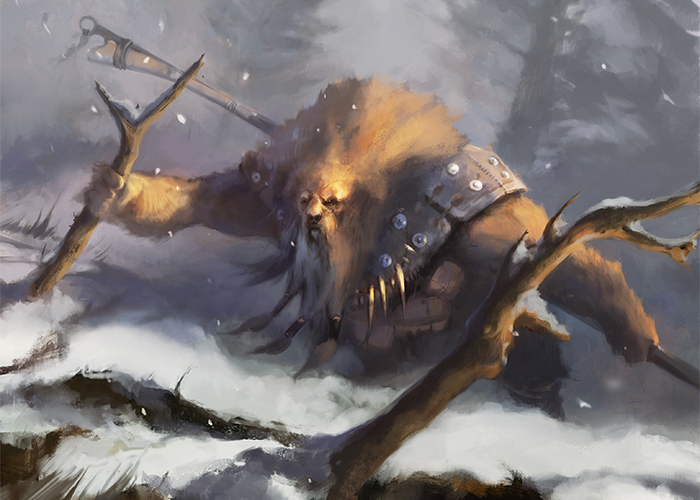
Art by Evan Shipard
Ainok are eager to fight at any time and for any reason. They lead clan attacks when they can. Where the humans pride themselves on toughness and compete among themselves as well as in battle to gain status, the ainok simply want meat. They wield weapons but are likely to enter a berserk state in the heat of battle, reverting to ancestral instincts and tearing into enemies with their powerful jaws. A blood-mad ainok might even devour raw, bloody chunks of a fallen opponent, although such behavior is considered an embarrassing loss of control. Afterward, the offender usually feels shame and disgust, and retreats for a period of cleansing.
The ainok also have a tradition of ritual fighting, both as battle training and as a way to winnow out those who were too weak to contribute effectively to the pack. Those who fail this test are cast out alone into the wilderness, almost certainly to die.
Isolated shamans: Temur whisperers are also sometimes known as the "weavers of the three destinies," referring to the past, the present (which they call "the now,"), and the future (called "the unwritten now"). They are far more aware of the continual and overlapping nature of time than ordinary Temur, seeing the past and the various possible presents all at the same time. They wear enormous headpieces that completely shade their upper faces. From these they hang fetishes and charms made from carved bone, antlers, relics, and the like. The assemblage serves to focus the shaman's whispering; the more tokens, the more powerful the ritual. On the oldest shamans, such heavily decorated headgear bows the wearer's shoulders.
Their eyes are never visible, symbolically reinforcing the idea that they whisper and listen to the ancestors and the elemental spirits, and see all times. They are by no means helpless; they move about unassisted and apparently are completely aware of their surroundings, although it's unknown to others whether this is magically assisted sight, augmented senses other than sight, or psychic sensitivity. The shamans do not explain themselves.

Art by Tyler Jacobson
The gender of a given whisperer is not apparent, given the concealing headgear and heavy clothing they all wear. It's only revealed when he or she enters trance to commune with the ancestors and elemental spirits, which the shamans only do in isolated places high in the mountains, all alone. Whisperers don't have an interest in procreation. They are found, not made. When a child shows the talent, he or she is taken away and raised in secretive crèches among the shamans, who bring in caretakers and guardians from the common folk.
Disowned Krumar: Occasionally, an orc krumar, an orphan raised within a human Abzan family, is cast out. With no desire to return to the clan of their ancestors, the Mardu, krumar in this situation find the family bonds of the Temur best reflect their previous life and find a new sense of purpose.
Clan Roles
The Dragonclaw: This is the official mantle of clan leadership, a title conferred through feats of battle, but which sometimes must be earned or defended in ritual challenge—usually a wrestling bout. The title can be held by anyone who can take it, regardless of age or gender.
First Father or First Mother: The highest-ranking member of the clan is considered the parent of all members. Sometimes, but not always, this role is also filled by the Dragonclaw, as in the case of the current leader, Surrak. The First Father or Mother has no spouse, but travels with other families and shares their encampments.
The One Who Whispers Twice: Although Temur shamans generally lead a hermetic existence, one is selected to be the clan advisor. This person, called the One Who Whispers Twice (once to the spirits and once to the Dragonclaw), must travel with the leader and his or her family instead of spending a life in solitary meditation, to guide the clan along the best path. This person provides military intelligence gleaned through magical divination and communication with spirits, warns of potential attacks, foresees the best grounds for hunting and raiding, and leads the summoning of ancestral troops in times of great need. He or she can initiate the Wide Whisper to consult with the other shamans when necessary.
The position is held for life. Whisperers don't compete to see who gets the job. Rather, it is seen as a sacrifice, giving up the pure life of communing with the spirits to deal with temporal issues. They convene at the sacred meeting place of the Dragon's Throat.
Each shaman whispers to one spirit, either elemental or ancestor, and the spirits decide on the most worthy choice. As compensation, the chosen one is able to commune psychically with not only other shamans, but with the frozen ancestors as they sleep (rather than first embodying them as ice doubles).
Hunt Caller: This person is responsible for the clan's pursuit of food animals, directing each family group to handle a particular area. He or she also commands raids against neighboring clans (typically Mardu) to seize supplies. The mantle of Hunt Caller can be held by anyone. It is earned rather than conferred, during the night of the Great Hunt. The hunter who brings back the greatest number of beasts, or the most formidable opponent, gains this title for the next year. The Hunt Caller is usually human, although ainok have sometimes held this position.
Temur landslide: A favored Temur battle tactic is to open with a downhill charge called the landslide, in which warriors ride battle sledges down the mountainside. Each sledge consists of a platform affixed to four or six two-handed, curved iron swords.
Warriors hurl spears or fire bows as they descend. Others wield something like the bang nakh (tiger claw) hand weapon, fashioned from bones, fangs, or carved dragon claws. After the initial impact with the enemy, the warriors leap off, flip the sledge over, and detach the swords from quick-release bindings to wade into melee. The Dragonclaw's chief lieutenant generally leads the charge beside the war leader.
Important Clan Figures
Surrak Dragonclaw. The khan of the Temur holds the title of Dragonclaw, which belongs to those who prove themselves in a ritual challenge. Surrak's challenge was to face an enormous bear in its cave lair, and he earned his title in a display of ferocious might still talked about years later. Descended from a long line of ancestors who also earned the Dragonclaw name, Surrak towers over his people in strength and stature.
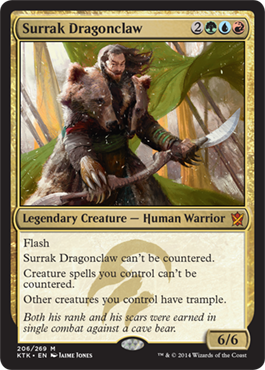
Surrak rarely speaks to his people, but when he does, he is pragmatic and harsh. He has little patience for frivolity, and he regards anything not tied to the continued survival of his people as a waste of resources.

Art by Jaime Jones
"If hard work and a prosperous hunt are not enough for our way of life, then we will do what must be done. If bones must break to protect my people, then they will break."
—Surrak Dragonclaw
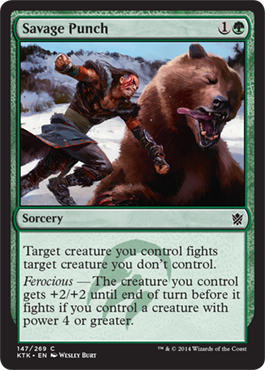
Nitula, the Hunt Caller: Nitula earned this title three years ago, when she fended off a pair of ogres singlehandedly, and in each following year she has continued to demonstrate her superiority. Most recently, she slew an enormous saber-toothed cat while still caring for her youngest child, whom she carried on her back throughout the hunting season.
Chianul, Who Whispers Twice: Chianul is old for a Temur, around fifty. (Life tends to be short due to a harsh environment and nearly constant warfare.) He was the One Who Whispers Twice when Surrak assumed the mantle of Dragonclaw, and he has seen another version of the "now" in which dragons are ascendant, leading the humans. Sarkhan Vol spent some time with Chianul as a young man, learning about his visions, voices, and knowledge of dragons. The old shaman recently led a Wide Whisper that revealed what he called a "weak point in the multiple nows." He believes Sarkhan needs to accompany him to this location to assist with a ritual that will "heal the now."
Baihir Torn-of-Ear: This ainok is a veteran of many battles and is known for her relatively cool head in combat. She secretly harbors resentment for the humans' dominance of the clan and hopes to seize power, should Surrak fall. She's not a sneaky political plotter, though; her ambition doesn't extend beyond making a play if the opportunity arises. Arranging a convenient accident for Surrak isn't her style, but encouraging him to risk himself in battle is. She is in contact with (and has had a child by) the rogue Kharkhel, and both seek the overthrow of the Dragonclaw.
Kharkhel: He was the runt of his ainok pack and could not compete with his bigger and stronger siblings. He was abandoned, but instead of giving up and dying, he found his way to a Mardu orc encampment. The orcs were amused by the "pup," as they called him, and kept him as something of a pet. He grew and thrived among the orcs, at first helping them in hunts, then as an ally in skirmishes. He developed battle techniques that depended more on tenacity and guile than on brute strength, making him a dangerous fighter despite his size. He eventually killed the orc leader in single combat and seized control of the tribe, which is now loosely allied with the Mardu. He and Baihir Torn-of-Ear both want to see the Temur humans reduced in power and are seeking a good opportunity to get Surrak conveniently dead.
Clan Creatures
Bears: From days long ago to now, the Temur have enjoyed a close partnership with bears. The beasts carry them into battle and draw their war wagons. They are seen as family members and welcomed with gifts of food as well as ceremonies giving thanks. The bears typically go their own way when not actively working with the clan but come in response to a call from the Dragonclaw (via the one Who Whispers Twice).
These great bears are enormous, shaggy brown beasts, standing perhaps ten feet at the shoulder, and weighing up to a ton. They inhabit caves and hollows and, while omnivorous, prefer meat when they can get it.
Elementals: Windfolk are elemental beings of snow and air who are found only at the highest elevations. Very few people have seen them, and only the whisperers are able to communicate with them. They are impervious to cold and wind, so they wear very little clothing—often only a simple wrap about the waist. Instead of hair or beards, they have mobile tentacles something like the barbels of catfish. They are psychically sensitive, detecting thoughts with their tentacles, and the shamans say that they can hear the humans' ancestors as well as the dreams of the dragons that still lie frozen in the ice.
The windfolk are reclusive, and their motives are not easy to discern. They sometimes congregate around certain locations, and such appearances are seen as omens of momentous events. Sometimes they arrive to help the Temur in battle, fighting in silence and departing immediately afterward. Even the whisperers don't know why they come; the windfolk do not seem to answer summons. When they speak with the human shamans, they utter brief, enigmatic phrases that spark long discussions in the Wide Whisper.
Ogres and goblins: These two races of savage humanoids are strangely akin. Adapted to the cold, both sport ruffs of thick, white fur and nearly spherical shapes to better retain body heat.
Goblins run in packs and are barely sentient, eating whatever they can get their claws on. They scavenge when they can but aren't above dragging down large prey (usually with significant losses) when the opportunity arises.

Art by Kev Walker
Ogres are more solitary, and sometimes they lead packs of goblins on raids. The Temur see both as pests in competition for scarce resources and hunt them relentlessly. The creatures' tough hides and white fur make for excellent boots.
Important Clan Locations
Karakyk Valley: Even the Temur cannot withstand the full force of winter in the mountains. They have two choices: Move to lower elevations—and conflict with the other tribes already living there—or "hibernate" until the weather turns, like the bears they emulate. While they don't fear battle, simply fighting for no good reason is unappealing to the Temur. So for the coldest two months of the year, all the wandering families congregate in a cirque (a glacier-carved valley) that legend says was created when a great dragon crashed to the ground at the End of All Dragons. The valley looks like it was scooped from the side of the mountain that faces away from the prevailing winter winds, and it has an overhanging lip that keeps off most snowfall. The clan has established permanent winter residences here, in contrast to the lightweight shelters they carry with them during the traveling months. These winter shelters are built into caves in the mountainside (incorporating shattered dragon bones from the valley floor), using elemental magic to grow the stone, freeze water into ice for carving, and otherwise shape the areas into comfortable shelters. A typical shelter is big enough to hold a family group. Each member contributes hides to cover the floor.
This period is spent largely napping, to conserve body heat and minimize food needs, with a lot of storytelling and maintenance or creation of clothing and tools. While the families are all gathered at Karakyk Valley, they hold community meetings to deal with clan business. Challenges to the Dragonclaw are resolved here, and children born since the previous gathering are formally introduced to the clan. Those of the First Father receive special tokens acknowledging their privileged origin.
Staircase of Bones: Outside of the winter months, the Temur sometimes assemble to hear the words of the Dragonclaw at the start of a war campaign. Word goes out through the Wide Whisper, and the various families gather at this hilltop. It is not a high peak, but its rounded top makes a good podium, and its relatively gentle slope allows easy climbing and standing or sitting as the clan leader speaks. It's also in a central location between the various family hunting grounds.
The locale gets its name from a spectacular battle in which the Temur devastated a swarm of attacking Mardu warriors. With charge after downhill charge, Surrak led his warriors against the invaders, leaving heaps of corpses so thick the hill seemed almost made of them. At the end of the battle, standing at the top, Surrak proclaimed that the Temur had climbed a staircase of their enemies' bones. The name stuck.
The Dragon's Throat: Deep within the mountains is a high, winding valley that once held a glacier but has since been exposed. Winds blow through this valley nearly constantly, and the windward end is much wider than the leeward end. The result is a continuous wail that is known as the Voice of Dragons. The Temur whisperers set up enormous harp-like instruments here, using dragon ribcages and skulls as the frames and twined sinews from food animals as strings. When the wind blows across them, these huge wind-harps add their own thrumming song to that of the valley, and the eerie music can be heard for miles. The shamans come here to whisper to very powerful spirits, adding the voice of the Dragon's Throat to their own.
Qal Sisma: The mountains that the Temur inhabit are not monolithic in nature. This region is more like a very high plateau that has been heavily eroded by rivers here and crumpled up by seismic activity there. The result is a deeply wrinkled, scarred landscape—much like the people who live there—with isolated, jagged peaks. The basic rock structure is old granite with a variably thick layer of sedimentary rock deposited on it during a period of glacial melting that covered much of the plateau with a shallow sea. When the climate cooled again, the waters receded and seismic action accelerated the process of petrification. The range now has numerous caves in areas covered by limestone, as well as unusual shapes formed by tumbled rocks, which are sometimes exploited for shelter or as areas of shamanic worship and meditation.
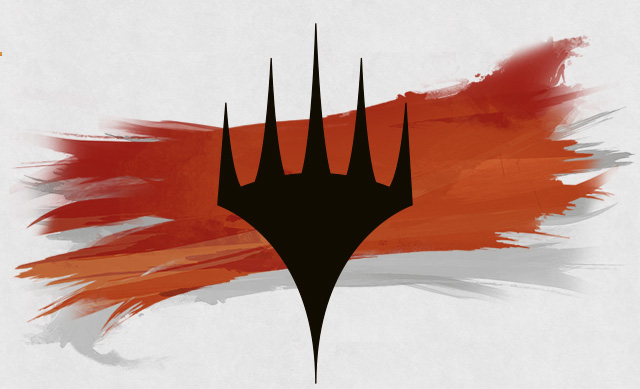
Planeswalkers
Sarkhan Vol
The dragon-worshipping Planeswalker Sarkhan Vol is a native of Tarkir, where dragons had gone extinct long before his birth. Obsessed with their fury and predatory majesty, Sarkhan learned as much as he could about his world's ancient dragons, even going so far as to join a group of infamous shamans who venerated the apex predators. He had a talent for battle and gained status as a warrior in the Mardu clan, but he soon tired of the petty quarrels of the battlefield.

Art by Daarken
After one victory against a rival clan, Sarkhan had an experience that changed his life:
"The spirit of a long-dead dragon appeared to him, whispered a spell into his mind, and then vanished forever. With the incantation of the spell, a huge dragon made of fire streaked out of Sarkhan's body and invaded the battle, blasting the battlefield with a torrent of fire. Fascinated, Sarkhan watched as his men and those of his enemy were burned to cinders. It was a display of ultimate rage and power that surpassed anything he had ever seen. It stoked a passion in him that had never before flared to life, and along with it, his Planeswalker spark."
—From the novel Alara Unbroken by Doug Beyer
Thereafter, Sarkhan traveled from plane to plane, looking for a dragon to whom he could dedicate his life. On Jund, a shard of the plane of Alara, he found a land ruled by tyrannical hellkites and other mighty dragons. There, he declared his fealty to the dragon Planeswalker Nicol Bolas. Disillusioned by his servitude to the villainous, conniving, woefully undragonlike Bolas, Sarkhan fell into madness. He has been led back to Tarkir by a voice in his mind, a voice he believes belongs to the spirit dragon Ugin. Sarkhan seeks a way to free his mind from madness and to liberate himself from Nicol Bolas, but he will soon learn that his world's entire history stands in his way.

Art by Volkan Baga
Sorin Markov
There is more at stake on Tarkir than the fate of Sarkhan and the clans. Elsewhere, the world-devouring entities known as the Eldrazi have arisen to feed on the planes of the Multiverse, and the key to stopping them may lie on Tarkir. The vampire Planeswalker Sorin Markov was one of three Planeswalkers who trapped the Eldrazi on the plane of Zendikar thousands of years before—the other two being the Lithomancer and Ugin, the spirit dragon. Now that the Eldrazi have awakened once more, Sorin is on a mission to reunite with these Planeswalkers.

Art by Cynthia Sheppard
But the Lithomancer's whereabouts are unknown, and Sorin has not encountered Ugin for over a thousand years. In an attempt to track down Ugin, Sorin has traveled to Tarkir, where the spirit dragon formed an important part of the planar ecosystem.
Fate will not be kind to Sorin's quest. Although Ugin was native to Tarkir and a source of powerful magic on the plane, the dragon was killed long ago. It was none other than Nicol Bolas who defeated Ugin, leaving him to die in an icy chasm. With Ugin dead and the Lithomancer still missing, Sorin may not have a chance to trap the Eldrazi again.

Art by Viktor Titov
